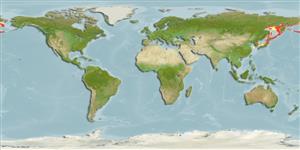Environment: milieu / climate zone / depth range / distribution range
Ecology
Marine; bathydemersal; depth range 55 - 913 m (Ref. 50550). Deep-water
Northeast Pacific: Sea of Okhotsk and Sea of Japan, the Tatar Strait, and the Pacific off Hokkaido and northern Honshu, Japan. Also west Bering Sea (Ref. 44380).
Size / Weight / Age
Maturity: Lm ? range ? - ? cm
Max length : 51.0 cm SL male/unsexed; (Ref. 83735)
Short description
Identification keys | Morphology | Morphometrics
Dorsal spines (total): 0; Dorsal soft rays (total): 57 - 62; Anal spines: 0; Anal soft rays: 50 - 55; Vertebrae: 62 - 67. Gill opening extending ventrally in front of 1 to 6 pectoral fin rays; disk length 12.7 to 16.7% of head length; body with cactus-like prickles (Ref. 559). Body uniformly pink; eye and peritoneum silver; stomach dusky (Ref. 559).
Life cycle and mating behavior
Maturity | Reproduction | Spawning | Eggs | Fecundity | Larvae
Masuda, H., K. Amaoka, C. Araga, T. Uyeno and T. Yoshino, 1984. The fishes of the Japanese Archipelago. Vol. 1. Tokai University Press, Tokyo, Japan. 437 p. (text). (Ref. 559)
IUCN Red List Status (Ref. 130435: Version 2024-1)
Threat to humans
Harmless
Human uses
Fisheries: of no interest
Tools
Special reports
Download XML
Internet sources
Estimates based on models
Preferred temperature (Ref.
123201): 0.1 - 3.6, mean 1.4 °C (based on 207 cells).
Phylogenetic diversity index (Ref.
82804): PD
50 = 0.5000 [Uniqueness, from 0.5 = low to 2.0 = high].
Bayesian length-weight: a=0.00589 (0.00340 - 0.01021), b=3.17 (3.02 - 3.32), in cm total length, based on LWR estimates for this species & Genus-body shape (Ref.
93245).
Trophic level (Ref.
69278): 3.3 ±0.49 se; based on food items.
Resilience (Ref.
120179): Medium, minimum population doubling time 1.4 - 4.4 years (Preliminary K or Fecundity.).
Fishing Vulnerability (Ref.
59153): Moderate vulnerability (45 of 100).
